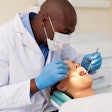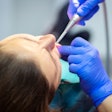
Uncle Sam is about to get his fingers wet.
An expansion of the Children's Health Insurance Program (CHIP), signed into law February 4, pours millions of new federal dollars into oral healthcare for children. But along with the money will come government scrutiny of dental healthcare -- including a consideration of superhygienists.
The law will more than double the number of children whose dental care is covered by CHIP (formerly State Children's Health Insurance Program [SCHIP]) from about 7 million to 15 million. "It's tremendous," said Burton Edelstein, D.D.S., M.P.H., who founded the Children's Dental Health Project in 1997 when SCHIP was originally passed without mandatory dental coverage.
What does it mean for private-practice dentists? In the short term, it may increase the chances someone will ask for care to be provided in exchange for government reimbursement. "More families will approach dentists," said Frank Catalanotto, D.M.D., a professor of community dentistry at the University of Florida and a spokesperson for Oral Health America.
The program will change in other ways as well. As with the previous version of CHIP, children and pregnant women are still eligible if their families earn between 100% and 200% of the federal poverty level: $22,000 to $44,000 for a family of four. (Families earning even less are covered by Medicaid.) States can also get some reimbursement for covering children and pregnant women up to 300% of the poverty level.
All states participating in CHIP will have to provide dental as well as medical benefits. Previously, states had the option of not offering dental coverage.
 |
| The U.S. government will spend $32.8 billion over four and a half years on the Children's Health Insurance Program. |
The new wrap
And for the first time, patients can get dental benefits through the program even if their other healthcare needs are covered by a different form of medical insurance. This change (known as the "dental wrap") will extend eligibility to 4 million children not otherwise covered by CHIP, according to Dr. Edelstein, a pediatric dentist and Columbia University professor.
Legal immigrants will also be covered; previously, states couldn't use federal dollars to cover immigrant children until they had lived in the U.S. for five years.
In other provisions:
- States will be required to inform parents about the importance of dental visits before their children's first birthday.
- A national task force will work to publicize the program.
- Public clinics can contract with private dentists to see patients through CHIP.
The expansion will be funded through a 62¢ tax on tobacco products; 1¢ was added to this tax specifically to fund the dental wrap. The total cost is estimated at $32.8 billion over four and a half years.
For some, the biggest question is how many dentists will say "yes" to children newly covered by CHIP. The answer to that will depend partly on how the states respond to the new legislation. Under the law, all states must cover eligible patients for care "necessary to prevent disease and promote oral health, restore oral structures to health and function, and treat emergency conditions" in children. But states have a lot of latitude in designing their own programs; currently, the reimbursement and the paperwork vary widely. Some have standalone CHIP programs, others have folded the program into Medicaid.
And with the recession undercutting state tax revenue, Dr. Catalanotto worries that many states will actually cut back because they can't afford to match the federal payments.
"This is not going to have a major impact in Florida and other states that are suffering as much," he said. He noted that Florida has declined federal money in the past to avoid having to match it.
For now, the paperwork involved in signing up for CHIP will probably be the same as it was under the old legislation. But because the programs vary so much from state to state, the best way to find out how to get involved is to contact your state dental association, Dr. Edelstein said.
Whatever approach states take will come under a new microscope. The federal government, in consultation with dental health professionals, will report on the quality of children's healthcare under Medicaid and CHIP.
Superhygienists considered
The legislation also requires the Government Accountability Office (GAO) to undertake studies of dental care for children in general and specifically to look into the "feasibility and appropriateness of using qualified midlevel dental health providers, in coordination with dentists, to improve access for children to oral health services and public health overall."
The term "midlevel provider" encompasses a wide range of proposed job descriptions for dental care providers licensed to do more than hygienists but less than dentists. In some models, such as the dental health aide therapists (DHATs) who now practice in Alaska, these new practitioners could do restorations and extractions.
Already the U.S. government has begun mulling over this hot-button issue in dentistry. At a February 9-11 workshop convened by the U.S. National Institute of Medicine (an independent, federally funded nonprofit organization), advocates presented five different models for this type of practitioner. "For those of us who are concerned about access to healthcare, it was extremely exciting," Dr. Catalanotto said.
But Dr. Edelstein noted that the government is still in the early stages of considering these options. In the meantime, he was celebrating the passage of legislation that resulted from more than a decade of constant pushing by the nation's leading oral health organizations. Dr. Edelstein particularly credited Sen. Olympia Snowe (R-ME), for leading the charge in the Senate on the dental wrap provision.
"The goal of this legislation is to provide high-quality, comprehensive, accountable dental insurance to 15 million children who are currently underserved and have a backlog of dental treatment needs," he said.
What happens next will depend a lot on the choices of individual dentists.
Copyright © 2009 DrBicuspid.com



















